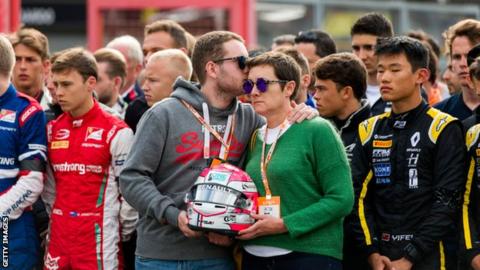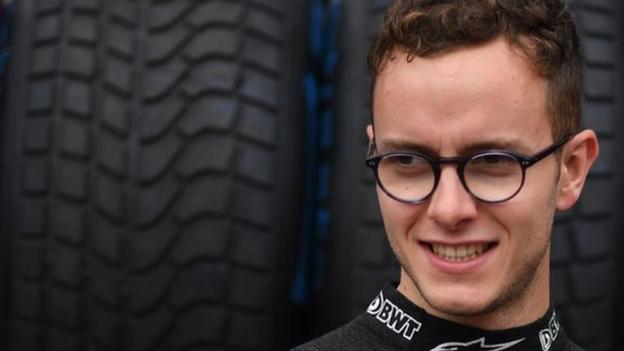
The death of Anthoine Hubert at last year’s Belgian Grand Prix had no single cause and no-one was to blame, the official report says.
Hubert was killed in a multi-car accident at the start of the Formula 2 race at Spa-Francorchamps on 31 August.
The report by governing body the FIA says Hubert was killed by a “non-survivable trauma” caused by the “extremely high level of energy transferred and dissipated”.
It concludes that none of the four drivers or officials involved acted inappropriately.
The Frenchman was subject to three impacts, the first with the barrier on the exit of the high-speed Raidillon corner, which he hit at 216km/h, generating a peak force of 33.7G; the second when he was hit by the car of American Juan Manuel Correa, which was a force of 81.8G; the third time when the impact with Correa sent him into the barrier again.
The FIA’s findings were that:
- “Multiple contributory factors giving rise to the severity of the accident were identified, following a detailed analysis of the various phases of the accident”.
- A chain of events led to a “protracted and complex crash sequence… which led to a high-speed ‘T-bone’-type impact between the cars of Hubert and Correa”, who suffered serious leg injuries in the crash.
- There was “no evidence that any driver failed to react appropriately in response to the yellow flag signal or to the circumstances on track”.
- The reaction of the trackside marshals and race control officials was “timely and good”.
The report, pulled together from video and physical evidence and data from the cars’ telemetry, detailed the events that led up to the fatal impact between Hubert and Correa.
- The accident sequence, which lasted a total of 14.6 seconds, was initiated when Giuliano Alesi spun on the exit of Turn Three (Eau Rouge), crashing into the barrier on the left-hand side of the track before rebounding back onto the circuit. There was a “high probability” this was caused by a loss of right-rear tyre pressure.
- Ralph Borschung and Hubert moved to the right to avoid the debris from Alesi’s car and into the run-off area of Turn Four (Raidillon). This happened before the yellow warning flags were waved, which was 1.8 seconds after Alesi’s impact.
- Hubert moved to the right to avoid Borschung, who had slowed more severely, but hit the back of the Swiss driver’s car at 262km/h.
- Hubert hit the barrier at Turn Four at an angle of approximately 40 degrees travelling at a speed of 216km/h, generating a peak force of 33.7G.
- Hubert’s car bounced back from the barrier, moving in the direction of racing while spinning, exposing the left-hand side of the chassis to oncoming cars.
- Correa hit the debris from Alesi’s car about 1.5 seconds after the yellow flag had been waved, breaking his front wing and front suspension, causing him to lose control.
- His car was sent on a trajectory that sent him into Hubert’s car 1.6 seconds later.
- Correa hit the side of Hubert’s car while it was virtually stationary at an angle of about 86 degrees at 218km/h. Correa experienced a force of 65.1G and Hubert 81.8G.
- This accelerated Hubert’s car to 105.4km/h. It hit the barrier a second time and bounced back towards the track.
- Double yellow flags were deployed 2.5 seconds after the car-to-car impact and a red flag stopping the race 2.7secs later, as Hubert’s car came to rest on track on its left-hand side.
- Correa’s car stopped upside down on track 2.6 seconds later.
- Medical teams responded 12 seconds after Alesi first lost control. The first medical evaluation of Hubert was conducted 54 seconds after the red flag.
- A fire started under Correa’s car 16 seconds after the red flag, caused by a fuel leak. This was extinguished within two seconds. Correa was evaluated by medics for the first tome 69 seconds after the red flag.
- The first extrication team was at the scene with two minutes of the accident.
The FIA said the conclusions from the accident would be “integrated into the ongoing work to further develop motorsport safety”.
